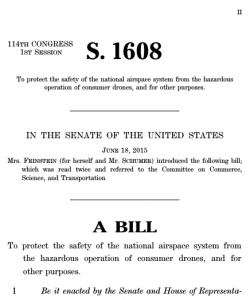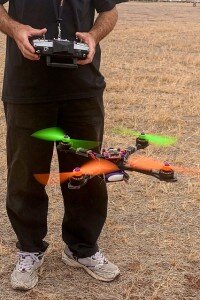Drones Are in the Air and in the News ― They Should Also Be on Board Agendas
When it comes to technology I am somewhat of a technophobe. I was a Blackberry holdout and I still read newspapers (the paper version) in my hand. So, not surprisingly, I hadn’t thought much about drones ― until I looked up recently and saw one buzzing over my deck with what looked like a high resolution camera. My first thought (“What is it?”) was followed quickly by, “Is it going to fall on my house, on my car or on my head?”I am by no means the only one asking these questions. As more businesses explore commercial uses of drones and more hobbyists fly them, regulators, lawmakers and consumers are recognizing the safety risks and liability concerns they create.The real-world applications for drones are seemingly limitless. Amazon and Google (among others) want to use drones to deliver packages; law enforcement agencies are already using them for surveillance; real estate professionals are eyeing them to market and inspect properties; and a non-profit development organization is using drones to document deteriorating conditions in the rain forest. The Federal Aviation Administration, which currently prohibits commercial uses of drones, is approving an estimated 250 “waivers” per month to permit commercial drone experiments assessing their potential. The agency estimates that there will be 30,000 commercial drones flying within the next four years. An insurance industry survey predicts that 40 percent of U.S. businesses will be using drones within that time frame.On the personal use side, plummeting prices for small drones (averaging $149 this year, compared with $350 two years ago) are attracting more enthusiasts. The Consumer Electronics Association estimates that hobbyists will purchase 700,000 drones this year, compared with just 128,000 two years ago.Cause for ConcernWhile the companies using drones (or planning to) and the hobbyists playing with them see their potential, others see cause for concern in five areas:
The Federal Aviation Administration, which currently prohibits commercial uses of drones, is approving an estimated 250 “waivers” per month to permit commercial drone experiments assessing their potential. The agency estimates that there will be 30,000 commercial drones flying within the next four years. An insurance industry survey predicts that 40 percent of U.S. businesses will be using drones within that time frame.On the personal use side, plummeting prices for small drones (averaging $149 this year, compared with $350 two years ago) are attracting more enthusiasts. The Consumer Electronics Association estimates that hobbyists will purchase 700,000 drones this year, compared with just 128,000 two years ago.Cause for ConcernWhile the companies using drones (or planning to) and the hobbyists playing with them see their potential, others see cause for concern in five areas:
- Civil liberties. Do law enforcement agencies tracking suspected criminal activity need search warrants for those surveillance efforts? And what do they do with the information they collect inadvertently about people who aren’t suspected of anything?
- Crime. Law enforcement officials aren’t the only ones using drones. Prisoners reportedly used a drone recently to smuggle drugs into an Ohio prison. And the Washington Post reports that the Department of Homeland Security has recorded 500 instances of “rogue” drones hovering over “sensitive sites and critical installations,” such as army bases and nuclear plants. There was also the widely reported incident in which a drone crash landed on the White House lawn.
- Physical injury and property damage. A few months ago, a low-flying drone struck a spectator watching a Memorial Day parade in Marblehead. An errant drone struck a woman watching a parade in Seattle, knocking her out, and another drone smashed into the side of a high-rise in Cincinnati.
- Privacy. “Naturists” sunbathing on a popular nude beach in England became incensed a when they were buzzed by a drone they suspected was photographing them. A homeowner in Kentucky shot down a drone he thought was spying on his daughters, and another homeowner in New Jersey opened fire on a neighbor’s drone that was taking pictures of homes in his neighborhood. From a safety standpoint, it’s hard to know whether to be more concerned about the drones or the people shooting at them.
- Air safety. This is the area causing the most concern. The FAA says it receives 25 reports every month about drones flying too close to airports and aircraft, including reports of nearly two-dozen near-mid-air collisions this year. Firefighters in California and elsewhere have complained bitterly about private drones interfering with their efforts to combat wildfires.
These incidents and others have led to demands for regulations and legislation to address public safety, privacy and other concerns.The Regulatory LandscapeFAA regulations currently bar commercial uses of drones, but the agency is drafting new rules that would open many of those doors, if not all of them. The proposed rules will require drone operators to pass a safety test, keep their drones in sight (without binoculars), fly them no faster than 100 miles per hour and no higher than 500 feet, and avoid flying them over people, other than the drone operator.The proposed rules won’t be finalized before next year, at the earliest, and they don’t address recreational drones (weighing less than 55 pounds), which currently fly through a loophole exempting them from the FAA’s existing ban. But Congress and some state lawmakers are beginning to target this sector, as well. The Consumer Drone Safety Act, sponsored by Sen. Dianne Feinstein (D-CA), would mandate an array of safety features for recreational drones and direct the FAA to adopt rules establishing height limits for flights and specifying the distance drones must maintain from airports, flight paths and public events.The National Conference of State Legislatures reports that 17 states have adopted drone-related measures; 45 states (Massachusetts among them) considered proposed legislation in the past year.Most of the measures that have been enacted or proposed target the use of drones for law enforcement purposes. In Massachusetts, a measure sponsored by Sen. Bob Hedland would require law enforcement officials to obtain a warrant before using drones for surveillance, and limit the information they could collect. The Massachusetts House is considering a similar measure.Elsewhere in New England, Maine and New Hampshire are among the 17 states that have approved drone restrictions. The Maine law requires law enforcement agencies to obtain the permission of elected officials before purchasing drones and obtain a warrant before using them in investigations. Reflecting a different concern, the New Hampshire statute, uniquely, bars the use of drones for hunting, fishing, or trapping. The Rhode Island legislature has approved a resolution calling for a study of drone regulations.Florida, one of the first states to restrict the use of drones by law enforcement agencies, recently approved another measure that would prohibit law enforcement officials or private parties from using drones to photograph people or their property without their permission “if a reasonable expectation of privacy exists.”A Mississippi law makes it a felony to use a drone for “peeping tom” activities and an Arkansas law similarly prohibits the use of drones for “voyeurism.”Issues for Condo Associations
The Consumer Drone Safety Act, sponsored by Sen. Dianne Feinstein (D-CA), would mandate an array of safety features for recreational drones and direct the FAA to adopt rules establishing height limits for flights and specifying the distance drones must maintain from airports, flight paths and public events.The National Conference of State Legislatures reports that 17 states have adopted drone-related measures; 45 states (Massachusetts among them) considered proposed legislation in the past year.Most of the measures that have been enacted or proposed target the use of drones for law enforcement purposes. In Massachusetts, a measure sponsored by Sen. Bob Hedland would require law enforcement officials to obtain a warrant before using drones for surveillance, and limit the information they could collect. The Massachusetts House is considering a similar measure.Elsewhere in New England, Maine and New Hampshire are among the 17 states that have approved drone restrictions. The Maine law requires law enforcement agencies to obtain the permission of elected officials before purchasing drones and obtain a warrant before using them in investigations. Reflecting a different concern, the New Hampshire statute, uniquely, bars the use of drones for hunting, fishing, or trapping. The Rhode Island legislature has approved a resolution calling for a study of drone regulations.Florida, one of the first states to restrict the use of drones by law enforcement agencies, recently approved another measure that would prohibit law enforcement officials or private parties from using drones to photograph people or their property without their permission “if a reasonable expectation of privacy exists.”A Mississippi law makes it a felony to use a drone for “peeping tom” activities and an Arkansas law similarly prohibits the use of drones for “voyeurism.”Issues for Condo Associations As is often the case with new technologies, drones have developed more rapidly than the laws and regulations governing them. Lawmakers and regulators are clearly struggling to catch up, and condominium associations should be paying attention, too.Some condo owners will almost certainly acquire recreational drones and others will almost certainly complain about the businesses or other owners that are using them.Can associations prohibit drones from flying over their property? If a drone operated by an owner or a business falls on another owner’s car, will the board be liable for the damage? Should associations impose restrictions on drones, and if so, what should they entail? Should boards themselves use drones to patrol common areas and spot rule violations? If they do, how should they manage the information and images they collect? How will boards balance the privacy concerns of some owners (“I don’t want my neighbor’s drone taking pictures of me!”) and the desire of others to operate drones and/or have them deliver pizzas and packages to their homes?These are just some of the questions boards will have to address. While it is too soon to offer definitive answers, a few preliminary observations may help trustees frame the issues.
As is often the case with new technologies, drones have developed more rapidly than the laws and regulations governing them. Lawmakers and regulators are clearly struggling to catch up, and condominium associations should be paying attention, too.Some condo owners will almost certainly acquire recreational drones and others will almost certainly complain about the businesses or other owners that are using them.Can associations prohibit drones from flying over their property? If a drone operated by an owner or a business falls on another owner’s car, will the board be liable for the damage? Should associations impose restrictions on drones, and if so, what should they entail? Should boards themselves use drones to patrol common areas and spot rule violations? If they do, how should they manage the information and images they collect? How will boards balance the privacy concerns of some owners (“I don’t want my neighbor’s drone taking pictures of me!”) and the desire of others to operate drones and/or have them deliver pizzas and packages to their homes?These are just some of the questions boards will have to address. While it is too soon to offer definitive answers, a few preliminary observations may help trustees frame the issues.
- Boards have the authority to adopt rules banning drones in common areas, and some association attorneys think they should do so proactively. Their concern: Boards that don’t control drones now may lose the ability to do so if federal or state laws or regulations broadly permit their operation.
- Instead of banning drones entirely, which will upset some owners, boards could consider regulations limiting their size or specifying where and when they can land in common areas. Although associations can’t ban the ownership of drones, they can prohibit drones from flying within a specified distance of owners’ units or require drone operators to obtain permission from residents before photographing them or their property.
- The liability concerns surrounding drones will be large and complicated. Insurance companies are just beginning to evaluate the risks and opportunities in this emerging market. Boards should check with their insurance agents to determine what their existing policies cover and what additional coverages they may need.
- Even if boards aren’t yet ready to act, they should start discussing policies, procedures and regulations governing drones before they begin fielding the inevitable questions, complaints and law suits related to them. Two years ago, we would have said that drones are coming. Today, we have to say, they’re here. The challenge for community associations is finding ways to live with them.
